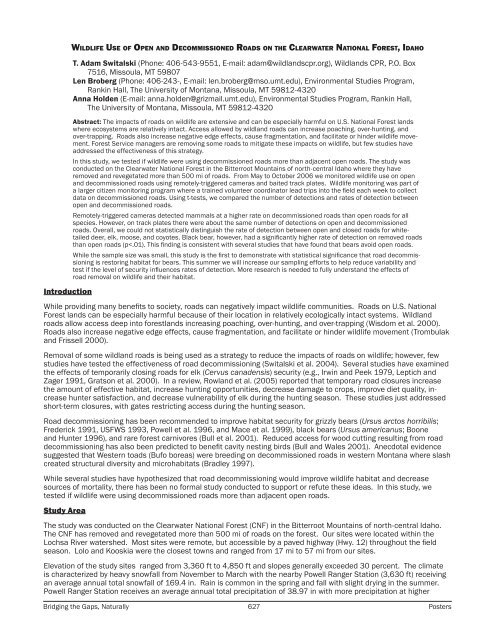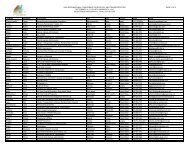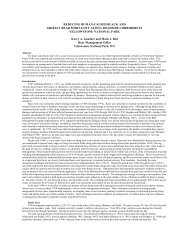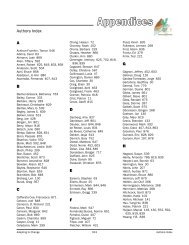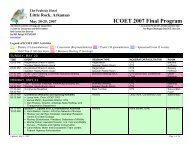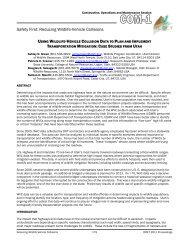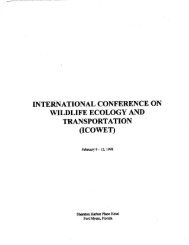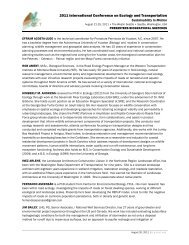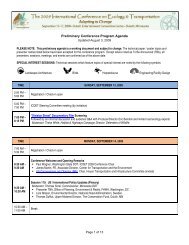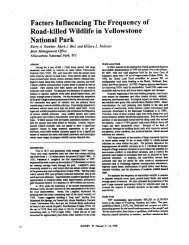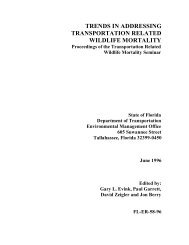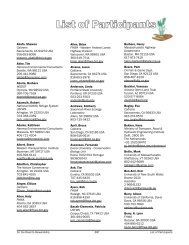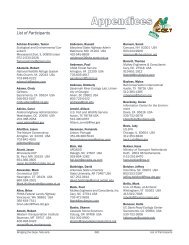Poster Sessions, pages 567-640 - ICOET
Poster Sessions, pages 567-640 - ICOET
Poster Sessions, pages 567-640 - ICOET
Create successful ePaper yourself
Turn your PDF publications into a flip-book with our unique Google optimized e-Paper software.
Introduction<br />
Wildlife Use of Open and Decommissioned Roads on the Clearwater National Forest, Idaho<br />
T. Adam Switalski (Phone: 406-543-9551, E-mail: adam@wildlandscpr.org), Wildlands CPR, P.O. Box<br />
7516, Missoula, MT 59807<br />
Len Broberg (Phone: 406-243-, E-mail: len.broberg@mso.umt.edu), Environmental Studies Program,<br />
Rankin Hall, The University of Montana, Missoula, MT 59812-4320<br />
Anna Holden (E-mail: anna.holden@grizmail.umt.edu), Environmental Studies Program, Rankin Hall,<br />
The University of Montana, Missoula, MT 59812-4320<br />
Abstract: The impacts of roads on wildlife are extensive and can be especially harmful on U.S. National Forest lands<br />
where ecosystems are relatively intact. Access allowed by wildland roads can increase poaching, over-hunting, and<br />
over-trapping. Roads also increase negative edge effects, cause fragmentation, and facilitate or hinder wildlife movement.<br />
Forest Service managers are removing some roads to mitigate these impacts on wildlife, but few studies have<br />
addressed the effectiveness of this strategy.<br />
In this study, we tested if wildlife were using decommissioned roads more than adjacent open roads. The study was<br />
conducted on the Clearwater National Forest in the Bitterroot Mountains of north-central Idaho where they have<br />
removed and revegetated more than 500 mi of roads. From May to October 2006 we monitored wildlife use on open<br />
and decommissioned roads using remotely-triggered cameras and baited track plates. Wildlife monitoring was part of<br />
a larger citizen monitoring program where a trained volunteer coordinator lead trips into the field each week to collect<br />
data on decommissioned roads. Using t-tests, we compared the number of detections and rates of detection between<br />
open and decommissioned roads.<br />
Remotely-triggered cameras detected mammals at a higher rate on decommissioned roads than open roads for all<br />
species. However, on track plates there were about the same number of detections on open and decommissioned<br />
roads. Overall, we could not statistically distinguish the rate of detection between open and closed roads for whitetailed<br />
deer, elk, moose, and coyotes. Black bear, however, had a significantly higher rate of detection on removed roads<br />
than open roads (p


